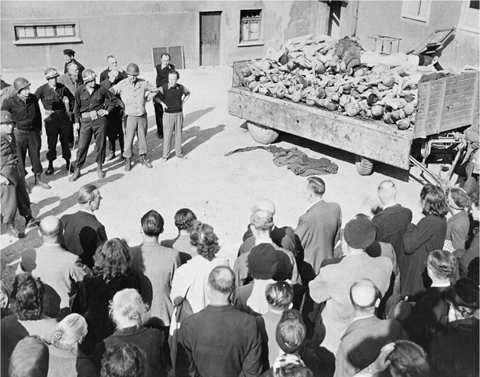
1 German civilians forced to wait in line to view the Buchenwald concentration camp, 1945.
2 German prisoners of war are forced to watch an atrocity film about the German concentration camps. The looks on the POWs’ faces indicate the range of emotions experienced by Germans at the end of the war.
3 The British sign erected in English and German at Bergen-Belsen concentration camp. The sign was put up following the torching of the ‘horror camp’ on 21 May 1945.
4 David Ben-Gurion addressing the Central Committee of Liberated Jews in Munich, 27 January 1946.
5 Children in Rosenheim DP camp. Such protests were a regular occurrence and the involvement of children was a clear attempt to try the world’s conscience.
6 The Landsberg and Föhrenwald football teams. Sport was of great importance in the DP camps, both in encouraging a return to physical health and in shaping communities.
7 Sonia Boczkowska performs the poem ‘Shoes from Majdanek’ at Belsen DP camp. Boczkowska, who had worked as an actress before the war, survived the Łódź and Będzin ghettos, then the slave labour camp Annaberg (a sub-camp of Gross-Rosen), Mauthausen and finally Belsen.
8 A scene from Partisans played by Katzet-Teater, Belsen DP camp. Partisans was one of the more popular pieces, giving surviving Jews a sense of agency and shifting the focus away from victimhood pure and simple.
9 The Yiddish Youth Theatre during a performance at Belsen DP camp.
10 Sally Katz of the Katzet-Teater performing in Die Mutter (The Mother) in Belsen DP camp. The piece dealt with a mother’s suffering following the murder of her child in a camp.
11 An effigy of Hitler during a Purim celebration, Landsberg DP camp.
12 Such re-enactments as this, at Landsberg DP camp, in the context of Purim both incorporated recent events into Jewish history and permitted the acting-out of revenge fantasies.
13 Students studying Talmud at a yeshiva in Zeilsheim DP camp, 1945. A remarkable number of survivors clung to the religious life they had followed before the war.
14 Zvi Silberman holds his newborn son in a DP camp in Austria. The sign behind him reads, ‘When Adar comes happiness is multiplied’. ‘Adar’ is the Jewish month in which Purim falls.
15 Clothing produced at an ORT-UNRRA school, probably at Landsberg DP camp. ORT provided large numbers of survivors with training in new professions.
16 Kibbutz Nocham, Belsen DP camp.
17 Exodus 1947 on a Jewish New Year greeting card. The travails of the Exodus provided a golden opportunity for Zionist propaganda.
18 A protest in Belsen DP camp against the treatment of Exodus 1947 passengers.
19 The ‘British Floating Dachau’ protest sticker.
20 Detention Camp no. 55 in Cyprus, the first of the camps in Karaolos to be opened to house illegal immigrants to Palestine. Inmates were housed in Nissen huts (visible in the background) and tents in two main sites on the island.
21 A wedding portrait in a Cyprus detention camp. Normal life continued as the refugees waited for their opportunity to leave for Palestine.